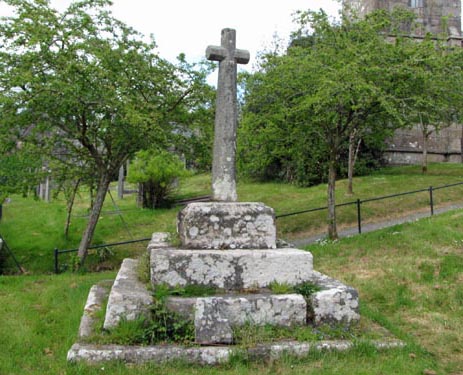 Location:
Just inside the main
gate to the churchyard. Location:
Just inside the main
gate to the churchyard.O/S Grid Ref: SX/50907/78737 Longitude/Latitude (Degrees+/-): -4.10760/50.58927 Map location: Click here to view map. Purpose: Village Cross Size: 6 feet (1.82 metres) tall. 1 foot 6 inches (0.46 metres) across the arms. Information: Although, due to its location, this may appear to be a churchyard cross, this is not the case. The site was once an open space within the village but, in 1880, it was decided to extend the churchyard. As a result, the village cross became included within the church boundary. On the face of it,
this elegant cross looks as though it is in good condition and has been
well cared for. However, all is not as it would seem. The socket stone and
those used in the pedestal are probably the only original parts of the
cross. It doesn’t appear as though the shaft is original, as it has been
fashioned from Roborough Down stone, rather than the granite used for the
socket and pedestal. Also the base of the shaft is slightly smaller than
the socket, so it is quite probable that this is the shaft of another
cross that has been reused. The tapered shaft is square at the bottom and octagonal above. The head and arms are also octagonal but it will be noticed that these are slightly out of proportion, being rather small for the size of the shaft. The pedestal is of three steps, composed of large rectangular blocks, that have been cemented into place. In similar style to the neighbouring Peter Tavy Village Cross, the four faces of the socket stone have been decoratively engraved in relief with a different design on each face, although I have not been able to discover the meaning of these designs. The designs, in the order of the eastern, northern, western and southern faces are shown in the thumbnail photos below: Whilst visiting this cross, spare a thought for William Crossing, the doyen of Dartmoor walkers and writers. Crossing and his wife, Emma, spent the last years of their lives in Mary Tavy and were both buried in this churchyard, to the East of the church. The house that they lived in is on the A386, the main road through Mary Tavy, and now bears a plaque to commemorate its former inhabitants. The house is appropriately named ’Crossing’.
There are a couple of interesting old tombstones fixed to the church wall. The inscription from one of these, dated in 1772, reads as follows: Here Buried were some
years before |